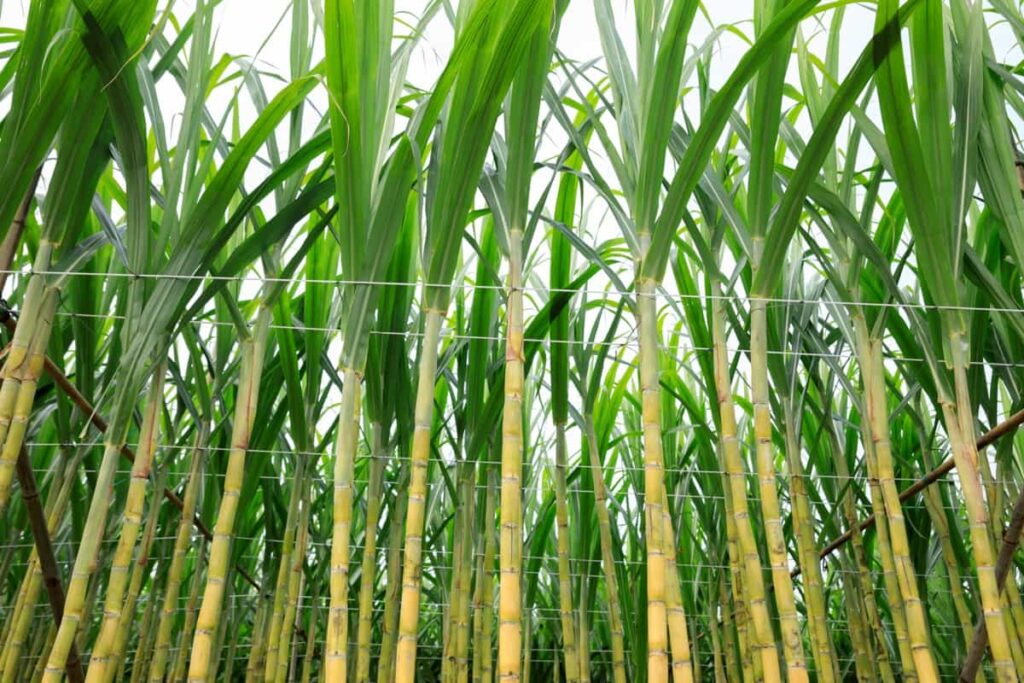Sugarcane cultivation requires meticulous attention to fertilizer scheduling and Nutrient management to optimize growth and yield. Understanding the crop’s nutrient requirements, soil testing, and employing appropriate fertilization techniques are crucial. This article explores the dosage, NPK ratio, and effective management strategies to enhance sugarcane productivity sustainably.

Sugarcane Fertilizer Schedule
Pre-Planting Soil Preparation
Before planting sugarcane, thorough soil testing and preparation are vital. Assessing soil fertility and pH levels helps determine nutrient deficiencies and acidity. Adequate soil tillage ensures optimal root development and nutrient uptake, setting the stage for healthy crop establishment and growth.
Soil Testing: Key to Nutrient Management
Sugarcane soil testing provides essential insights into soil health and nutrient availability. Analyzing soil samples reveals deficiencies in primary nutrients like nitrogen, phosphorus, and potassium, guiding fertilizer applications. Regular testing enables precise nutrient management, optimizing cane growth, and maximizing yield potential.
Adjusting Soil pH: Lime and Sulfur Applications
Sugarcane soil testing provides essential insights into soil health and nutrient availability. Analyzing soil samples reveals deficiencies in primary nutrients like nitrogen, phosphorus, and potassium, guiding fertilizer applications. Regular testing enables precise nutrient management, optimizing cane growth, and maximizing yield potential.
Nutrient Requirements of Sugarcane
Sugarcane thrives on a balanced diet of nutrients, primarily requiring nitrogen (N), phosphorus (P), and potassium (K). Additionally, it benefits from secondary and micronutrients like calcium, magnesium, sulfur, iron, manganese, zinc, copper, and boron. Adequate nutrition ensures robust growth, high yields, and better sugar content in the cane.
NPK Ratios: Foundation of Fertilizer Programs
NPK ratios, indicating the proportion of nitrogen, phosphorus, and potassium in fertilizers, are crucial for optimal crop nutrition. Common ratios include 4:2:1, 2:1:1, and 1:1:1, catering to different crop needs. Understanding these ratios helps tailor fertilizer applications to match specific nutrient requirements at various growth stages, promoting healthy development and maximizing yields.
Importance of Secondary and Micronutrients
While primary nutrients like N, P, and K are vital for plant growth, secondary and micronutrients play equally important roles. Calcium aids in cell wall formation, magnesium is essential for photosynthesis, and sulfur contributes to protein synthesis. Micronutrients like iron, manganese, zinc, copper, and boron are necessary for enzyme activation and overall metabolic functions, ensuring optimal plant health and productivity.
In case you missed it: Sugarcane Cultivation Cost Per Acre in India: Exploring State-wise Average Production Cost

Nitrogen (N) Management
Nitrogen is a key commponent of amino acids, proteins, chlorophyll, and nucleic acids, essential for plant growth and development. Effective nitrogen management involves supplying adequate amounts at critical growth stages while minimizing losses through leaching, volatilization, and denitrification. Proper timing, rates, and application methods optimize nitrogen utilization, promoting vigorous vegetative growth and maximizing crop yields.
Estimating Nitrogen Needs Throughout the Crop Cycle
Accurate estimation of nitrogen requirements throughout the crop cycle is essential for efficient fertilizer management. Factors such as soil type, variety, weather conditions, and crop stage influence nitrogen demand. Soil tests, plant tissue analysis, and predictive models help determine nitrogen availability and uptake, enabling precise fertilizer applications to meet crop needs and minimize environmental impacts.
Application Timing and Methods for Nitrogen
Timing and method of nitrogen application significantly affect its utilization efficiency and crop performance. Split applications, dividing nitrogen doses into multiple applications during the growing season, match nutrient supply with crop demand, reducing losses and enhancing uptake. Foliar sprays, fertigation, and soil incorporation are common methods, each offering advantages depending on crop requirements, soil conditions, and equipment availability.
Phosphorus (P) Application
Phosphorus is crucial for sugarcane growth, aiding in root development, energy transfer, and flowering. Typical application rates range from 30 to 60 kg P2O5 per hectare. It’s best applied before planting, either broadcasted or placed in bands, to ensure proper root access. Soil testing helps determine the specific phosphorus needs of each field.
Assessing Phosphorus Requirements
Assessing phosphorus needs involves soil testing to measure existing levels and determine necessary adjustments. Ideal soil phosphorus levels for sugarcane range from 10 to 20 ppm (parts per million). Based on test results, fertilization strategies are tailored to meet crop demands while minimizing environmental impact. Regular monitoring ensures optimal phosphorus levels throughout the growing season.
Phosphorus Application Techniques for Maximum Efficiency
To maximize phosphorus efficiency, consider application methods such as banding or placement near the root zone. Applying phosphorus with organic matter can enhance nutrient uptake and soil health. Timing is critical, with pre-plant or early-season applications recommended. Avoiding phosphorus runoff safeguards water quality and promotes sustainable sugarcane production.
Potassium (K) Fertilization
Potassium is essential for sugarcane, aiding in photosynthesis, water uptake, and disease resistance. Typical application rates range from 100 to 200 kg of K2O per hectare. It’s commonly applied before planting or as a side dressing during the growing season. Soil testing guides potassium application, ensuring optimal crop nutrition and yield potential.
Determining Potassium Dosage for Optimal Growth
Determining potassium dosage involves soil testing to assess existing levels and crop requirements. Sugarcane typically requires soil potassium levels between 100 to 200 ppm. Fertilization strategies aim to maintain these levels while accounting for potassium uptake and soil characteristics. Adjustments may be made based on plant tissue analysis and visual symptoms of deficiency.
Split Applications of Potassium for Sustained Uptake
Splitting potassium applications promotes sustained nutrient uptake and minimizes losses. Dividing the total potassium dosage into multiple applications throughout the growing season aligns with sugarcane nutrient demand. Timing applications with critical growth stages optimizes potassium availability when the crop needs it most. Proper management of split applications enhances nutrient use efficiency and overall crop performance.
In case you missed it: The Ultimate Guide to Growing Key Lime: Best Farming Practices for Beginners

Secondary Nutrients and Micronutrient Supplementation
In sugarcane cultivation, secondary nutrients and micronutrients play crucial roles in ensuring optimal growth and yield. Secondary nutrients like calcium, magnesium, and sulfur, along with micronutrients such as boron, zinc, and iron, contribute to various physiological processes in the plant. Proper supplementation of these nutrients through fertilization programs helps address deficiencies and promotes healthy sugarcane development.
Role of Calcium, Magnesium, and Sulfur in Sugarcane
Calcium, magnesium, and sulfur are vital elements for sugarcane growth and productivity. Calcium aids in cell wall formation and enhances plant structure and strength. Magnesium is a key element for chlorophyll, essential for photosynthesis. Sulfur contributes to protein synthesis and enzyme activity. These nutrients must be supplied adequately to support optimum sugarcane growth, development, and sugar yield.
Micronutrient Deficiencies: Identification and Correction
Micronutrient deficits can greatly impact the development and productivity of sugarcane. Symptoms, including leaf yellowing, decreased sugar content, and stunted development, are indicative of deficits in boron, zinc, and iron. In order to guarantee healthy sugarcane crops, focused correction through micronutrient supplementation tactics like foliar sprays or soil application is made possible by soil and tissue testing, which aids in the identification of these deficiencies.
Fertilizer Application Techniques
Efficient fertilizer application is crucial for maximizing nutrient uptake and optimizing sugarcane yield. Techniques such as banding, where fertilizers are placed in bands near the plant roots, and broadcast application, where fertilizers are spread evenly over the soil surface, are commonly used. Proper timing, placement, and dosage of fertilizers ensure balanced nutrient availability throughout the growing season.
Broadcast vs. Banding: Pros and Cons
Broadcast and banding are two primary methods of fertilizer application in sugarcane cultivation, each with its advantages and disadvantages. The broadcast application allows for uniform nutrient distribution across the field but may result in nutrient loss through leaching or runoff. Banding concentrates nutrients near the root zone, promoting efficient uptake, but requires precise placement and may be labor-intensive.
The Role of Foliar Fertilization in Sugarcane Production
Foliar fertilization involves applying nutrient solutions directly to the leaves, allowing for rapid absorption and utilization by the plant. This technique is particularly useful for correcting nutrient deficiencies during critical growth stages or under adverse soil conditions. Foliar sprays can supplement traditional soil-applied fertilizers, providing a convenient and effective means of nutrient delivery in sugarcane production.
Organic Fertilization and Soil Health
Organic fertilization practices promote soil health and sustainability in sugarcane production systems. The use of organic matter such as compost, manure, or green manure enriches the soil with essential nutrients and improves its structure, water retention, and microbial activity. Organic fertilizers contribute to long-term soil fertility, enhance nutrient cycling, and reduce environmental impacts associated with chemical fertilizers.
Incorporating Organic Matter: Benefits for Soil Fertility
Incorporating organic matter into sugarcane fields offers numerous benefits for soil fertility and crop productivity. Organic materials provide a slow-release source of nutrients, improving soil structure and moisture retention. They also stimulate microbial activity, promoting nutrient cycling and enhancing nutrient availability to sugarcane plants. Additionally, organic amendments contribute to carbon sequestration, mitigating climate change impacts in agriculture.
Biofertilizers: Enhancing Nutrient Availability and Uptake
Biofertilizers, such as nitrogen-fixing bacteria, phosphate-solubilizing microbes, and mycorrhizal fungi, offer sustainable alternatives to conventional fertilizers in sugarcane production. These beneficial microorganisms enhance nutrient availability and uptake by forming symbiotic relationships with plant roots or by solubilizing nutrients in the soil. Biofertilizers improve soil fertility, reduce chemical inputs, and promote eco-friendly practices in sugarcane cultivation.
Irrigation and Nutrient Management
To ensure optimal growth and yield in sugarcane, proper irrigation and nutrient management are crucial. Farmers employ various techniques such as drip irrigation, furrow irrigation, and sprinkler systems to deliver water efficiently to the crops. Additionally, balanced fertilization practices are essential to provide sugarcane with the necessary nutrients for healthy development and high sugar content.
Water Management Practices for Efficient Fertilizer Use
Efficient water management is essential for maximizing the effectiveness of fertilizer application in sugarcane cultivation. Farmers utilize strategies like controlled irrigation scheduling and precision irrigation technologies to deliver water precisely where and when the crop needs it most. This ensures that fertilizers are efficiently absorbed by the plants, minimizing nutrient leaching and maximizing nutrient uptake for optimal growth.
Effects of Irrigation Schedules on Nutrient Leaching
The timing and frequency of irrigation have significant effects on nutrient leaching in sugarcane fields. Over-irrigation can lead to excessive leaching of essential nutrients like nitrogen, potassium, and phosphorus, reducing their availability to the crops and potentially causing environmental pollution. Proper irrigation scheduling based on crop water requirements helps minimize nutrient losses and ensures efficient nutrient uptake by sugarcane plants.
Monitoring Crop Nutrition and Adjusting Practices
Regular monitoring of crop nutrition is essential for identifying any deficiencies or imbalances in nutrient uptake by sugarcane plants. Farmers conduct soil tests, tissue analysis, and nutrient monitoring throughout the growing season to analyze the plant’s nutrient status accurately. Based on these observations, adjustments to fertilizer application rates and timing can be made to optimize nutrient management and ensure healthy crop development.
In case you missed it: How to Make Homemade Fertilizer for Greenhouse Crops

Tissue Testing: Tracking Plant Nutrient Status
Tissue testing is a valuable tool for monitoring the nutrient status of sugarcane plants throughout the growing season. By analyzing leaf samples, farmers can accurately assess the plant’s nutrient uptake and identify any deficiencies or excesses. This allows for timely adjustments to fertilizer application rates and formulations to meet the crop’s nutritional needs and maximize yield potential.
Adjusting Fertilizer Practices Based on Growth
As sugarcane plants grow and develop, their nutrient requirements change accordingly. Farmers adjust fertilizer practices based on the crop’s growth stage, soil conditions, and nutrient uptake patterns. By closely monitoring plant growth and response to fertilizer applications, farmers can fine-tune their nutrient management strategies to optimize yield, quality, and sustainability in sugarcane production.
Conclusion
Achieving optimal yield and quality in sugarcane cultivation requires careful attention to nutrient management. Understanding the crop’s nutrient requirements through soil testing is crucial for developing an effective fertilizer schedule. Balancing NPK ratios, incorporating micronutrients, and optimizing irrigation practices are key factors in maximizing fertilizer efficiency and promoting healthy sugarcane growth throughout its growth cycle.
- Crops Grown in Summer Season: Best Choices for Summer Gardening
- Organic Pest Control for Tomato Farming
- How to Maximize Sheep Farming Profit
- Broccoli Varieties: Choosing the Right Cultivars for Your Farm
- How to Raise Pigs in Your Own Backyard: A Comprehensive Guide
- Budget Friendly Sheep Shed Ideas: Cheap and Low-Cost Tips
- How Much Do Cattle Farmers Make: Revenue Streams in Cattle Farming
- Management Pests and Diseases in Your Cotton Field
- Sheep Farming Business Plan for Beginners
